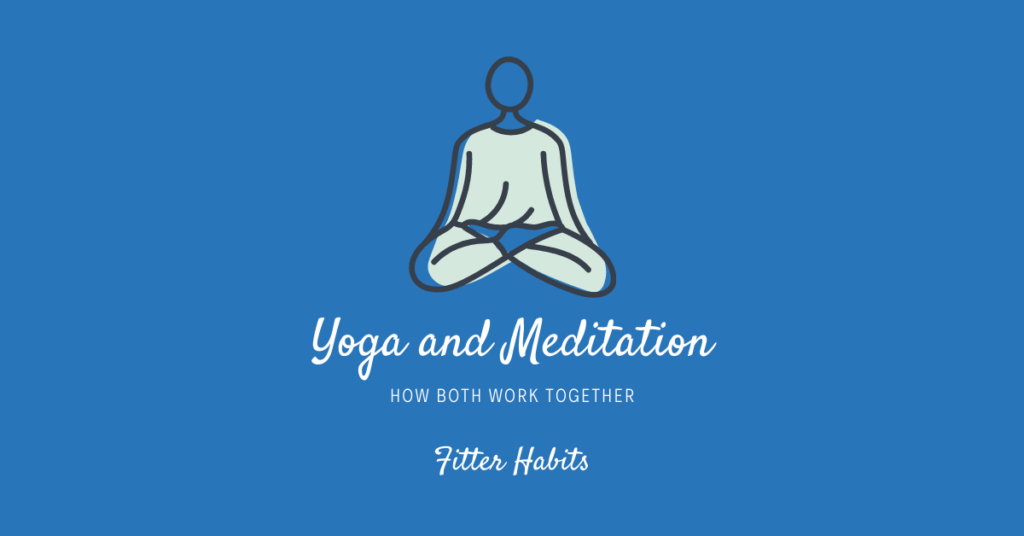Yoga and meditation are often practiced together as of cultivating mental and physical health. We explain why.
Many people’s first experience of a deep meditative state comes at the end of a yoga class. Their bodies are loose and tired. Their minds are quiet and focused. When the instructor guides the class into savasana, the students receive the rare gift of uninterrupted time for pure relaxation. Their heart rates slow. The world around them dissolves. They feel inner peace.
In a certain sense, yoga and meditation are one and the same, and not just when it is time for savasana.
Meditation, like yoga, takes many forms, but both meditation and yoga are primarily concerned with quieting the mind, reaching a deeper and more interconnected state of consciousness, and harmonizing mind, body, and spirit. Read on for more information and tips about how to make better use of yoga meditation.
Contents
Benefits of Meditation
Anyone who meditates regularly as part of their yoga practice knows the benefits intuitively, but the fact that yoga increases wellness is also backed up by extensive scientific research.
The science-backed benefits of meditation include stress reduction (and improvement of stress-related conditions ranging from irritable bowel syndrome to PTSD), reduction of mental anxiety and physical pain, lower blood pressure, improved self-esteem and self-awareness, longer attention span, improved memory and immune system, greater success in fighting addiction, better sleep, and more.
Meditation and the Eightfold Path of Yoga

The Yoga Sutras, an ancient and foundational Indian text by Patanjali, describe Ashtanga yoga, otherwise known as Eight Limbed yoga, Raja yoga, or the Eightfold Path (sometimes illustrated by the Dharma wheel). The goal of Ashtanga yoga is systematic control over mind and body through eight practices.
The first two limbs include rules for behavior (such as pacifism, vegetarianism, honesty, austerity, and worship). The third is Asana, the physical activity most westerners associate with yoga. The fourth is Prana, control of life-force energy. The fifth is withdrawal of the senses from the material world.
These five initial limbs set the yogi up for the last three: Dharana (concentration), Dhyana (meditation), and Samadhi (transcendence).
In other words, meditation is not the highest goal of yoga, but it is an advanced stage of consciousness that is a precondition for reaching Samadhi, union with the divine, when the “I” disappears. These final three limbs are the essence of a meditation practice
Tips for Focusing Attention in Meditation (Dharana)
Dharana is a good form of meditation for beginners, who have only tried types of meditation like practicing mindfulness or relaxing during savasana. Dharana, translated as concentration, involves fixing your mind on something specific and clearing your mind of everything else.
What to Fix Your Mind On While Practicing Dharana
Breath
Direct all of your attention to the air you are breathing as it enters and exits your body. Take slow, deep, yogic breaths, using your diaphragm, perhaps pausing at the top of the inhale and the bottom of the exhale. Consider practicing other pranayama breathing techniques.
Mantra
Choose a simple mantra and recite it repeatedly (mentally or orally) as you practice slow, deep breathing. This could be as simple as repeating a slow ohm each time you exhale. Another good example is to think the word “I am…” as you inhale, and “…here now” as you exhale.
Object
If you have a very visual imagination and have difficulty clearing your mind with closed eyes, consider keeping your eyes half-open during meditation and allow them to settle on a specific point in space or object. The flame of a candle is a pleasantly hypnotic option. You could also keep your eyes closed but focus on visualization of an intangible object, like a deity or your chakras.
Tips for Continuousness of Meditation (Dhyana)
If you have practiced Dharana, you may find yourself occasionally slipping into a deep meditative state, Dhyana, which is sometimes translated as glimpsing the soul or slipping into the gaps between thoughts. There are many things you can do to help you reach that state more easily and consistently in your yoga practice.
Suggestions for Practicing Dharana
Posture
Eliminating physical distractions so you can focus on the present moment is much easier if you meditate in a comfortable position. That could be sitting cross-legged on a stack of pillows, sitting in a chair with back support, or even lying flat on the floor. In any position, aim for a loose but straight spine, make sure you feel rooted to the earth, and listen to your body.
Fundamentals
While you do not have to perfectly master the earlier six limbs of Ashtanga yoga to practice Dharna, if you have difficulty reaching a deep meditative state it may help to revisit the other limbs. For example, if you told a lie earlier in the day, intrusive thoughts about that lie may stop you from quieting your mind during meditation.
Time
Experiment with meditating for different periods of time. Some meditators quit too quickly, before they reach a deep state of consciousness. Alternatively, others easy to get into a focused state of mind initially, but are pulled out of it by intrusive thoughts. They should shorten their meditations, to exit the meditative state deliberately. Ten to fifteen minutes is a good place to start.
Environment
Eliminate distractions. Put a note on the door saying you should not be disturbed. Turn on the heater or cover yourself in a blanket if your room is cool. Turn off your phone, or put it on Do Not Disturb if you are using a yoga app for your timer. Yoga apps are also a great source for white noise or nature sounds, which will help eliminate the distraction of background noise.
Tips for Aspiring to Enlightenment (Samadhi)
Samadhi is a climactic state of enlightenment that can occur at the time of death, according to the Yoga Sutras. Samadhi is the total bliss that comes with the unification of all aspects of being: physical, spiritual, mental, and emotional.
Self-awareness
Practicing yoga can help you identify and accept your own limitations, whether it’s tight hamstrings that stop you from touching your toes or anxiety that produces intrusive thoughts. Developing greater understanding of yourself, with honesty and without judgment, is a major step in deepening your meditative practice.
Integration
Samadhi is about unifying all parts of yourself, so find opportunities to integrate meditative practices in your daily life. If you spend all day sitting in front of a computer, make it a habit to stop every hour to do a few seated yoga poses.
f you have a long commute or wash the dishes every night, use that time to practice clearing your mind of everything other than pure concentration on driving or dishwashing.
Noticing
While Samadhi is considered an ultimate state, you have likely experienced “lower samadhis” many times. These are moments of perfect flow in life, which can occur while meditating or during intense periods of creative activity, high-level performance, or physical or emotional intimacy, for example.
This state of flow allows you to escape tyranny of time, and brings bliss and extreme relaxation. These moments are a form of transcendence, so notice them and enjoy them.
Final Word: Yoga and Meditation
Yoga and meditation are both skills to practice often. Your practice of meditation will improve your asana practice and vice versa. We hope these tips allow you to take your meditation to the next level and set the stage for greater transcendence, relaxation, and bliss in your yoga practice.
You’ll also love our round-up of the best meditation apps.



